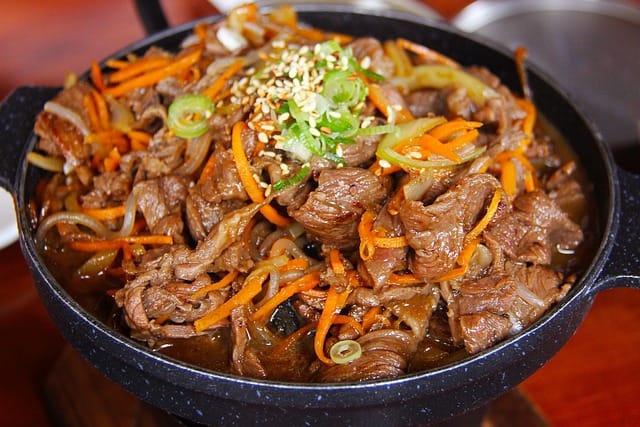Bulgogi is one of Korea’s most iconic meat dishes, featuring thinly sliced beef marinated in a flavorful sauce and grilled to perfection. It boasts a delightful blend of sweet and savory flavors, making it a favorite among Koreans and foreigners alike.
History of Bulgogi
- Bulgogi’s origins can be traced back to a dish called Maekjeok (貊炙) from the Goryeo Dynasty. Maekjeok involved skewering meat on sticks and grilling it, considered the prototype of bulgogi.
- During the Joseon Dynasty, a dish called Neobiani emerged, which involved marinating thinly sliced beef in a sauce and grilling it. Neobiani shared a similar cooking method with bulgogi and is believed to have influenced its development.
- The modern form of bulgogi appeared in the early 20th century. During the Japanese colonial period, Japanese-style yakiniku was introduced, which was adapted into the Korean style, resulting in today’s bulgogi.
Types of Bulgogi
- Seoul-style Bulgogi: Characterized by grilling the meat in a broth.
- Gwangyang-style Bulgogi: Features thinly sliced meat grilled quickly over charcoal on a gridiron.
- Eonyang-style Bulgogi: Involves mincing thinly sliced meat and grilling it over charcoal.
Tips for Enjoying Bulgogi
- Use fresh meat.
- Marinate the meat in the sauce for an adequate amount of time.
- Grilling over charcoal enhances the flavor.
- Enjoy it with fresh vegetables such as lettuce and perilla leaves.
Bulgogi is a quintessential Korean dish that can be enjoyed in various forms and cooking styles. If you visit Korea, be sure to give it a try.
English Translation:
Bulgogi is one of Korea’s most iconic meat dishes, featuring thinly sliced beef marinated in a flavorful sauce and grilled to perfection. It boasts a delightful blend of sweet and savory flavors, making it a favorite among Koreans and foreigners alike.
Tips for Enjoying Bulgogi
- Use fresh meat.
- Marinate the meat in the sauce for an adequate amount of time.
- Grilling over charcoal enhances the flavor.
- Enjoy it with fresh vegetables such as lettuce and perilla leaves.
Bulgogi is a quintessential Korean dish that can be enjoyed in various forms and cooking styles. If you visit Korea, be sure to give it a try.
Translation: Busan, South Korea
- Eonyang Bulgogi Busan Main Branch is located at 8, Namcheonbada-ro 33beon-gil, Suyeong-gu, Busan, South Korea. It has a rating of 4.3 stars on Google Maps.
- Eonyang Bulgogi Busan is located at 32, Namcheonbada-ro, Suyeong-gu, Busan, South Korea. It has a rating of 4 stars on Google Maps.
- Parkgane Eonyang Bulgogi is located at 74, Suyeong-ro 540beon-gil, Suyeong-gu, Busan, South Korea. It has a rating of 4.4 stars on Google Maps.
- Original Eonyang Bulgogi is located at 16, Gwangan-ro 84beon-gil, Suyeong-gu, Busan, South Korea. It has a rating of 4.1 stars on Google Maps.
- Jinmi Eonyang Bulgogi is located at 7, Namcheonbada-ro 33beon-gil, Suyeong-gu, Busan, South Korea. It has a rating of 4.2 stars on Google Maps.
Here are some highly-rated bulgogi restaurants in the Seoul and Gyeonggi regions:
- 한가네불고기 in Insadong, Seoul, is known for its flavorful bulgogi and friendly service. It has a rating of 4.6 stars on Google Maps.
- 옛맛서울불고기 in Jajang-dong, Seoul, is a popular spot for bulgogi lovers. It has a rating of 4.3 stars on Google Maps.
- 청진식당 in Jongno, Seoul, is a historic restaurant that has been serving bulgogi for over 50 years. It has a rating of 4.1 stars on Google Maps.
- 옛맛서울불고기 in Mapo-gu, Seoul, is another popular option for bulgogi. It has a rating of 3.9 stars on Google Maps.
- 송도불고기 올림픽공원 in Songpa-gu, Seoul, is a great place to enjoy bulgogi in a casual atmosphere. It has a rating of 4 stars on Google Maps.
These are just a few of the many great bulgogi restaurants in the Seoul and Gyeonggi regions. With so many options to choose from, you’re sure to find the perfect spot to enjoy this delicious Korean dish.
